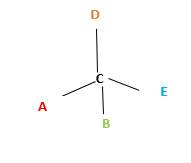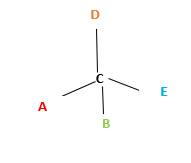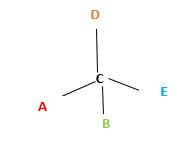
Concept explainers
(a)
Interpretation:
Chalk should be classified as chiral or achiral.
Concept Introduction:
Chirality is the presence of an asymmetric carbon center in a molecule and a molecule which contains a chiral center cannot superimpose on its mirror image. To consider as chiral, molecule or object and its mirror image should not superimpose. To consider as achiral, molecule or object and its mirror image should be superimposed with each other.

In the above diagram, where C is the chiral center/ asymmetric carbon center.
A, B, D, E are four different
Answer to Problem 21P
Chalk is achiral.
Explanation of Solution
To consider as chiral, molecule or object and its mirror image should not superimpose. To consider as achiral, molecule or object and its mirror image should be superimposed with each other. The mirror image of chalk is identical and is superimposable on their mirror images. Though they have not sharpened edges, the object and its mirror images are superimposable with each other. Thus, chalk is achiral.
(b)
Interpretation:
Pair of shoes should be classified as chiral or achiral.
Concept Introduction:
Chirality is the presence of an asymmetric carbon center in a molecule and a molecule which contains a chiral center cannot superimpose on its mirror image. To consider as chiral, molecule or object and its mirror image should not superimpose. To consider as achiral, molecule or object and its mirror image should be superimposed with each other.

In the above diagram, where C is the chiral center/ asymmetric carbon center.
A, B, D, E are four different functional groups.
Answer to Problem 21P
Pair of shoes are chiral.
Explanation of Solution
To consider as chiral, molecule or object and its mirror image should not superimpose. To consider as achiral, molecule or object and its mirror image should be superimposed with each other. The mirror image of pair of shoes arenot identical and not superimposable. The object and its mirror images are not superimposable with each otherand not align all the parts of the objects with its mirror image. Thus, pair of shoes are chiral.
(c)
Interpretation:
A football should be classified as chiral or achiral.
Concept Introduction:
Chirality is the presence of an asymmetric carbon center in a molecule and a molecule which contains a chiral center cannot superimpose on its mirror image. To consider as chiral, molecule or object and its mirror image should not superimpose. To consider as achiral, molecule or object and its mirror image should be superimposed with each other.

In the above diagram, where C is the chiral center/ asymmetric carbon center.
A, B, D, E are four different functional groups.
Answer to Problem 21P
Football is achiral.
Explanation of Solution
To be considered as chiral, molecule or object and its mirror image should not superimpose. To consider as achiral, molecule or object and its mirror image should be superimposed with each other. The mirror image of a football is identical and superimposable. The object and its mirror images are superimposable with each other. Thus, football is achiral.
Want to see more full solutions like this?
Chapter 15 Solutions
Connect One Semester Access Card for General, Organic, & Biological Chemistry
- Don't used Ai solutionarrow_forwardDraw a Lewis dot structure for C2H4Oarrow_forward3.3 Consider the variation of molar Gibbs energy with pressure. 3.3.1 Write the mathematical expression for the slope of graph of molar Gibbs energy against 3.3.2 pressure at constant temperature. Draw in same diagram graphs showing variation with pressure of molar Gibbs energies of a substance in gaseous, liquid and solid forms at constant temperature. 3.3.3 Indicate in your graphs melting and boiling points. 3.3.4 Indicate for the respective phases the regions of relative stability.arrow_forward
- In 2-chloropropane, the signal for the H on the C next to Cl should be split into how many peaks?arrow_forward4.4 Consider as perfect gas 3.0 mol of argon gas to which 229 J of energy is supplied as heat at constant pressure and temperature increases by 2.55 K. Calculate 4.4.1 constant pressure molar heat capacity. 4.4.2 constant volume molar heat capacity.arrow_forward3.2 32 Consider calibrating a calorimeter and measuring heat transferred. A sample of compound was burned in a calorimeter and a temperature change of 3.33°C recorded. When a 1.23 A current from a 12.0 V source was passed through a heater in the same calorimeter for 156 s, the temperature changed of 4.47°C was recorded. 3.2.1 Calculate the heat supplied by the heater. 3.2.2 Calculate the calorimeter constant. 3.2.3 Calculate the heat released by the combustion reaction.arrow_forward
- -.1 Consider the standard enthalpy of formation of gaseous water at 25°C as -241.82 kJ/mol and calculate the standard enthalpy of formation of gaseous water at 100°C.arrow_forward3.5 Complete the following sentences to make correct scientific meaning. 3.5.1 The entropy of a perfect gas. 3.5.2 when it expands isothermally. The change in entropy of a substance accompanying a change of state at its transition 3.5.3 temperature is calculated from its of transition. The increase in entropy when a substance is heated is calculated from itsarrow_forward3.4 Consider the internal energy of a substance 3.4.1 Draw a graph showing the variation of internal energy with temperature at constant volume 3.4.2 Write the mathematical expression for the slope in your graph in 3.4.1arrow_forward
- For a system, the excited state decays to the ground state with a half-life of 15 ns, emitting radiation of 6000 Å. Determine the Einstein coefficients for stimulated absorption and spontaneous emission and the dipole moment of the transition. Data: epsilon 0 = 8.85419x10-12 C2m-1J-1arrow_forwardProblem a. The following compounds have the same molecular formula as benzene. How many monobrominated products could each form? 1. HC =CC=CCH2CH3 2. CH2=CHC = CCH=CH₂ b. How many dibrominated products could each of the preceding compounds form? (Do not include stereoisomers.)arrow_forwardDon't used Ai solutionarrow_forward
 Organic ChemistryChemistryISBN:9781305580350Author:William H. Brown, Brent L. Iverson, Eric Anslyn, Christopher S. FootePublisher:Cengage Learning
Organic ChemistryChemistryISBN:9781305580350Author:William H. Brown, Brent L. Iverson, Eric Anslyn, Christopher S. FootePublisher:Cengage Learning
